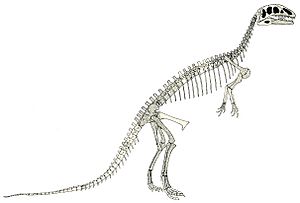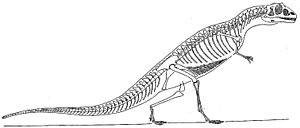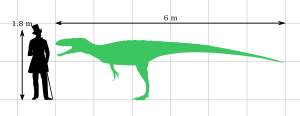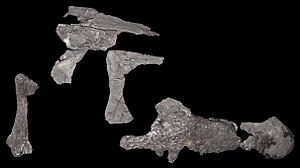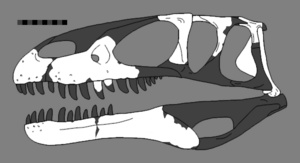Eustreptospondylus facts for kids
Quick facts for kids Eustreptospondylus |
|
|---|---|
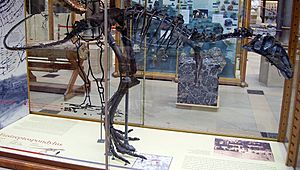 |
|
| Mounted holotype skeleton | |
| Scientific classification | |
| Genus: |
Eustreptospondylus
|
| Species: |
oxoniensis
|
| Synonyms | |
|
|
Eustreptospondylus (say "yoo-STREP-toh-spon-DYE-lus") was a type of meat-eating dinosaur called a theropod. It belonged to a group known as megalosaurids. This dinosaur lived during the Oxfordian stage of the Late Jurassic period, which was about 163 to 154 million years ago. It roamed what is now southern England. Back then, Europe was a collection of many scattered islands because of how the land and sea were moving.
Contents
Discovering and Naming Eustreptospondylus
In 1870, some workers found the skeleton of a theropod dinosaur in a brick pit near Oxford, England. A local bookseller, James Parker, got the bones and showed them to Professor John Phillips at Oxford. Phillips wrote about the bones in 1871, but he didn't give the dinosaur a name. At that time, it was the most complete skeleton of a large meat-eating dinosaur ever found. Even today, Eustreptospondylus is still the most complete large Jurassic theropod found in Europe.
In 1890, Oxford University bought the skeleton. A scientist named Arthur Smith Woodward thought it was a type of Megalosaurus. Later, in 1905 and 1906, Baron Franz Nopcsa believed it was a species called Streptospondylus cuvieri. This name came from a dinosaur first described in 1842 by Sir Richard Owen, but that dinosaur was only known from a single lost bone. Trying to link a complete skeleton to a dinosaur known from very few bones was tricky!
In 1964, a scientist named Alick Donald Walker cleared things up. He gave the Oxford skeleton its own unique name: Eustreptospondylus oxoniensis. The name Eustreptospondylus means "true Streptospondylus". The word Streptospondylus means "turned vertebra" in Greek. This refers to how its backbones were shaped differently from those of crocodiles. The second part of the name, "oxoniensis," simply means "from Oxford," where it was found.
The main fossil, called the holotype (which is the single most important specimen for naming a species), is known as OUM J13558. It was found in claystone from a sea layer that is about 162 million years old. This fossil is a fairly complete skeleton, but it's missing some parts of the skull, lower arms, and the end of its tail. It belonged to a dinosaur that was not yet fully grown.
In 2000, Oliver Walter Mischa Rauhut noticed that Eustreptospondylus was very similar to another megalosaurid called Magnosaurus. He suggested in 2003 that they might be the same genus. However, most scientists still see them as separate.
What Eustreptospondylus Looked Like
The main Eustreptospondylus fossil was not from a fully grown dinosaur. Scientists believe it was about 4.6 meters (15 feet) long and weighed around 218 kilograms (480 pounds). If it had grown to full size, it might have reached about 6 meters (20 feet) long and weighed around 500 kilograms (1,100 pounds). This made it an "average-sized" theropod.
The skull of Eustreptospondylus had a somewhat pointed snout when seen from the side. It had a large nostril that pointed sideways. Unlike some other dinosaurs, it didn't have a horn above its eye. The top of its skull was quite thick. Its jaw joints had special grooves that allowed its mouth to open very wide. The front part of its lower jaws was tall and wide. Even though no teeth were found in the fossil, the size of the tooth sockets shows that the third tooth in its lower jaw was larger than the others.
Special Features
Scientists have found a few special features that help tell Eustreptospondylus apart from its close relatives. For example, it had a small dip with a hole in a bone near its eye. Also, a bone at the back of its skull had a flap that hung down. Its tenth neck bone had a clear dip on its front underside. These small details help experts identify Eustreptospondylus fossils.
Dinosaur Family Tree
In 1964, Alick Walker placed Eustreptospondylus in the Megalosauridae family. Today, Eustreptospondylus is usually considered a member of a smaller group within the Megalosauridae family called the Eustreptospondylinae.
Here's a simplified look at where Eustreptospondylus fits in the dinosaur family tree:
| Megalosauroidea |
|
|||||||||||||||||||||||||||||||||||||||||||||||||||||||||||||||
How Eustreptospondylus Lived
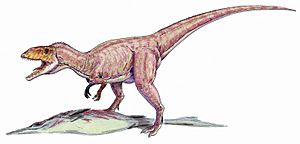
What it Ate
Like many other theropods, Eustreptospondylus was a predator. It probably hunted smaller dinosaurs and flying reptiles called pterosaurs. It might also have eaten dead animals, like fish, sea reptiles, or other dinosaurs. It could have searched for food along ancient shorelines.
Could it Swim?
The fossil of Eustreptospondylus was found in an area that was once an island. This makes scientists wonder if it could swim short distances. Some think Eustreptospondylus was a good swimmer, strong enough to swim between islands, much like a modern Komodo dragon.
However, not all scientists agree. Other ideas suggest that the dinosaur might have died on the mainland and its body was then washed out to sea during a flood. Or, it could have died in a river and been carried to the ocean.
Island Dwarfism Idea
For a while, some people thought Eustreptospondylus was an example of island dwarfism. This is when animals on islands evolve to become smaller over time because there's less food or space. But in 2000, scientists David Martill and Darren Naish pointed out that the main fossil was from a dinosaur that wasn't fully grown. This means it wasn't a dwarf species, just a young one.
See also
 In Spanish: Eustreptospondylus oxoniensis para niños
In Spanish: Eustreptospondylus oxoniensis para niños


